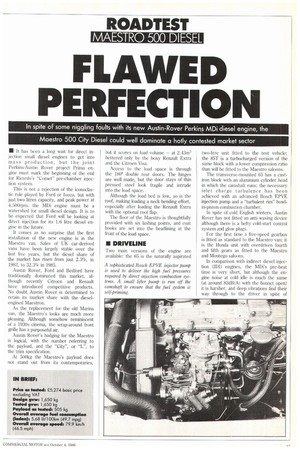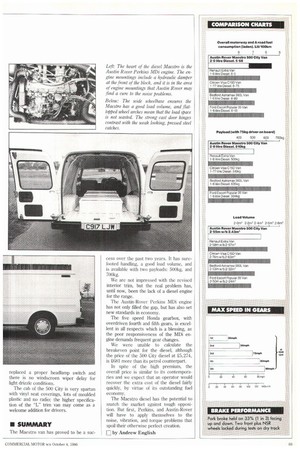FLAW RFECTION
Page 69

Page 70

Page 71

If you've noticed an error in this article please click here to report it so we can fix it.
In spite of some niggling faults with its new Austin-Rover Perkins MDi diesel engine, the Maestro 500 City Diesel could well dominate a hotly contested market sector
• It has been a long wait for direct injection small diesel engines to get into mass production, but the joint Perkins/Austin Rover project Prima engine must mark the beginning of the end for Ricardo's "Comet" pre-chamber injection system.
This is not a rejection of the iconoclastic role played by Ford or Iveco, but with just two litres capacity, and peak power at 4,500rpm, the MIN engine must be a watershed for small diesel design. It is to be expected that Ford will be looking at direct injection for its 1.6 litre diesel engine in the future.
It comes as no surprise that the first installation of the new engine is in the Maestro van. Sales of UK car-derived vans have been largely stable over the last five years, but the diesel share of the market has risen from just 2.3%, in 1982, to 32.3% in 1985.
Austin Rover, Ford and Bedford have traditionally dominated this market, although recently Citroen and Renault have introduced competitive products. No doubt Austin Rover is determined to retain its market share with the dieselengined Maestros.
As the replacement for the old Marina van, the Maestro's looks are much more pleasing. Although somehow reminiscent of a 1930s cinema, the wrap-around front grille has a purposeful air.
Austin Rover's badging for the Maestro is logical, with the number referring to the payload, and the "City", or "L", to the trim specification.
At 500kg the Maestro's payload does not stand out from its contemporaries,
but it scores on load volume — at 2.43m3 bettered only by the boxy Renault Extra and the Citroen Visa.
Access to the load space is through the 180° double rear doors. The hinges are well made, but the door stays of thin pressed steel look fragile and intrude into the load space.
Although the load bed is low, so is the roof, making loading a neck bending effort, especially after loading the Renault Extra with the optional roof flap.
The floor of the Maestro is thoughtfully provided with six lashing points, and coat hooks are set into the headlining at the front of the load space.
• DRIVELINE
Two main versions of the engine are available: the 65 is the naturally aspirated A sophisticated Bosch EPVE injector Pump is used to deliver the high fuel pressures required by direct injection combustion systems. A small lifter pump is run off the camshaft to ensure that the fuel system is self-priming. two-litre unit fitted to the test vehicle; the 85T is a turbocharged version of the same block with a lower compression ratio than will be fitted to the Maestro saloons.
The transverse-mounted 65 has a castiron block with an aluminium cylinder head in which the camshaft runs; the necessary inlet charge turbulence has been achieved with an advanced Bosch EPVE injection pump and a "turbulent rim" bowlin-piston combustion chamber.
In spite of cold English winters, Austin Rover has not fitted an anti-waxing device although there is a hefty cold-start control system and glow plugs.
For the first time a five-speed gearbox is fitted as standard to the Maestro van; it is the Honda unit with overdriven fourth and fifth gears as fitted to the Maestro and Montego saloons.
In comparison with indirect diesel injection (IDI) engines, the MDi's pre-heat time is very short, but although the engine noise at cold idle is much the same (at around 82dB(A) with the bonnet open) it is harsher, and deep vibrations find their way through to the driver in spite of some sophisticated engine mountings.
On the move the vibration and harshness are still there, with the offside door mirror's image blurred at most speeds. The empty van body resonates with the engine and the booming sound is very tiring on long journeys.
The Honda five-speed gearbox is a superb unit with precise changes, wellspaced ratios and short throws with a light clutch, which enables one to keep the engine revving.
Unfortunately, the gearbox has to be used to its full capabilities as the engine lacks the torque of its ID! contemporaries. That poor responsiveness and lack of urgency means that even gentle motorway slopes have to be tackled in a lower gear, which adds to driver fatigue.
• ECONOMY
The engineering simplicity of the DI system has its main advantage in fuel economy, as the inlet charge is only used to drive the piston and power is not wasted against the walls of the pre-combustion chamber.
The Perkins DI diesel has now set new standards for production small diesel economy with the outstanding laden figure of 5.681it/100km (49.7mpg) on our Kent light van test route.
No other vehicle in this class can achieve a laden figure of under 6111/100km. The best is the Ford Escort Popular's 6.131it/100km; the Renault Extra, Citroen Visa and Bedford Astramax all return figures greater than 6.5.
• ROAD HOLDING
The Maestro's MacPherson strut front suspension and single leaf supported beam axle at the rear make light work of sharp corners and uneven road surfaces. On a cross-country run from the Motor Industry Research Association proving ground to South-East Essex the van could be driven with complete confidence. The suspension seems to squat on braking or cornering, and the steering feels direct, without too much feedback.
• INTERIOR
The fascia has had an uplift since we tested the Maestro 700 (CM, June 8, 1985), which we consider a retrograde step. The dashboard has an adequate complement of warning lights and a speedometer, fuel and temperature gauges, but the ventilation controls and ancillary switches are placed so as to be completely obscured to the driver.
A thumb dial on the indicator stalk has replaced a proper headlamp switch and there is no windscreen wiper delay for light drizzle conditions.
The cab of the 500 City is very spartan with vinyl seat coverings, lots of moulded plastic and no radio; the higher specification of the "L" trim van may come as a welcome addition for drivers.
• SUMMARY
The Maestro van has proved to be a suc cess over the past two years. It has surefooted handling, a good load volume, and is available with two payloads: 500kg, and 700kg.
We are not impressed with the revised interior trim, but the real problem has, until now, been the lack of a diesel engine for the range.
The Austin-Rover Perkins MDi engine has not only filled the gap, but has also set new standards in economy.
The five speed Honda gearbox, with overdriven fourth and fifth gears, is excellent in all respects which is a blessing, as the poor responsiveness of the MDi engine demands frequent gear changes.
We were unable to calculate the breakeven point for the diesel, although the price of the 500 City diesel at V5,274, is £581 more than its petrol counterpart.
In spite of the high premium, the overall price is similar to its contemporaries and we expect that an operator would recover the extra cost of the diesel fairly quickly, by virtue of its outstanding fuel economy.
The Maestro diesel has the potential to snatch the market against tough opposition. But first, Perkins, and Austin-Rover will have to apply themselves to the noise, vibration, and torque problems that spoil their otherwise perfect creation.
11 by Andrew English








































































































































